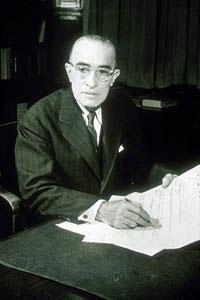Loading...
Please wait while we load the content.
Please wait while we load the content.

In 1915 Chauncey Griffith, Linotype sales rep in Kentucky, wrote to management criticizing the new specimen book. He pointed out that the library consisted of a long list of filled customers’ orders with no control of duplicate designs, no standard character sizes or sets. He proposed that only the best version of each design should be used as a model, and cut in a complete set of sizes and characters. After a two-day meeting management gave him control of the factory. He promptly introduced his standards, but barely survived the morning when management came to work and discovered that he had scrapped the secondary faces that he considered junk, the bulk of the old library.
By 1920 he was Assistant to the President, and before long he was pricing all the machines. He wasted little time in reorganizing newspaper text letting, first with Ionic No. 5, then Excelsior, with its lighter and bolder “grades”, Paragon and Opticon. In 1940, he introduced Corona, champion of the teletype era, the most popular textface in newspaper history. In 1938 he had introduced Bell Gothic, the type that revolutionized production of telephone books.
For the commercial world he designed the Poster Bodonis, then Janson and Monticello. Working with W.A Dwiggins and Rudolf Ruzika, he produced the well-known series that became the center of American publishing. Both found that working with “Griff” regularly became a challenging, satisfying, and profitable experience. Trained skills of design imagination were theirs; regularity of fit, color, and duplexing was his. His quiet pleasure was the personal design of non-roman fonts that opened new markets for Linotype machines. The list includes: Porson and Metro Greek; thirteen Arabic designs adaptable for use throughout the Muslem world; Hebrews; the Indian scripts devanagari, Gujarati, and Bengali; Sinhalese for use in Ceylon, Tamil, and Syriac.
A natural autocrat in his industrial dealings, he was largely unknown outside Mergenthaler. Within the company he was respected and feared. He viewed the provision of typefaces of high quality throughout the world, roman and non-roman, as a lifetime’s work. He was hugely respected within the factory, respected (and beloved) within the drawing office, and truly beloved by his outside designers, W.A. Dwiggins and Rudolf Ruzika.
